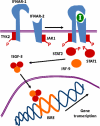Effect of type-I interferon on retroviruses
- PMID: 21994560
- PMCID: PMC3185530
- DOI: 10.3390/v1030545
Effect of type-I interferon on retroviruses
Abstract
Type-I interferons (IFN-I) play an important role in the innate immune response to several retroviruses. They seem to be effective in controlling the in vivo infection, though many of the clinical signs of retroviral infection may be due to their continual presence which over-stimulates the immune system and activates apoptosis. IFN-I not only affect the immune system, but also operate directly on virus replication. Most data suggest that the in vitro treatment with IFN-I of retrovirus infected cells inhibits the final stages of virogenesis, avoiding the correct assembly of viral particles and their budding, even though the mechanism is not well understood. However, in some retroviruses IFN-I may also act at a previous stage as some retroviral LTRs posses sequences homologous to the IFN-stimulated response element (ISRE). When stimulated, ISREs control viral transcription. HIV-1 displays several mechanisms for evading IFN-I, such as through Tat and Nef. Besides IFN-α and IFN-β, some other type I IFN, such as IFN-τ and IFN-ω, have potent antiviral activity and are promising treatment drugs.
Keywords: FeLV; HIV-1; HTLV-I; ISRE; MuLV; Type-I interferons; retrovirus.
Figures





Similar articles
-
Positive and Negative Regulation of Type I Interferons by the Human T Cell Leukemia Virus Antisense Protein HBZ.J Virol. 2017 Sep 27;91(20):e00853-17. doi: 10.1128/JVI.00853-17. Print 2017 Oct 15. J Virol. 2017. PMID: 28768861 Free PMC article.
-
Selective Interferon Responses of Intestinal Epithelial Cells Minimize Tumor Necrosis Factor Alpha Cytotoxicity.J Virol. 2020 Oct 14;94(21):e00603-20. doi: 10.1128/JVI.00603-20. Print 2020 Oct 14. J Virol. 2020. PMID: 32847859 Free PMC article.
-
Ribavirin treatment up-regulates antiviral gene expression via the interferon-stimulated response element in respiratory syncytial virus-infected epithelial cells.J Virol. 2003 May;77(10):5933-47. doi: 10.1128/jvi.77.10.5933-5947.2003. J Virol. 2003. PMID: 12719586 Free PMC article.
-
Unmasking immune sensing of retroviruses: interplay between innate sensors and host effectors.Cytokine Growth Factor Rev. 2014 Dec;25(6):657-68. doi: 10.1016/j.cytogfr.2014.08.006. Epub 2014 Sep 3. Cytokine Growth Factor Rev. 2014. PMID: 25240798 Review.
-
[Interferons: between structure and function].Postepy Hig Med Dosw (Online). 2014 May 6;68:428-40. doi: 10.5604/17322693.1101229. Postepy Hig Med Dosw (Online). 2014. PMID: 24864095 Review. Polish.
Cited by
-
Avian Leukosis: Will We Be Able to Get Rid of It?Animals (Basel). 2023 Jul 19;13(14):2358. doi: 10.3390/ani13142358. Animals (Basel). 2023. PMID: 37508135 Free PMC article. Review.
-
Clinical and Hematological Follow-Up of Long-Term Oral Therapy with Type-I Interferon in Cats Naturally Infected with Feline Leukemia Virus or Feline Immunodeficiency Virus.Animals (Basel). 2020 Aug 20;10(9):1464. doi: 10.3390/ani10091464. Animals (Basel). 2020. PMID: 32825496 Free PMC article.
-
Efficacy of antiviral chemotherapy for retrovirus-infected cats: What does the current literature tell us?J Feline Med Surg. 2015 Nov;17(11):925-39. doi: 10.1177/1098612X15610676. J Feline Med Surg. 2015. PMID: 26486979 Free PMC article. Review.
-
Efficacy of Antiviral Drugs against Feline Immunodeficiency Virus.Vet Sci. 2015 Dec 18;2(4):456-476. doi: 10.3390/vetsci2040456. Vet Sci. 2015. PMID: 29061953 Free PMC article. Review.
-
Maedi-Visna virus: current perspectives.Vet Med (Auckl). 2018 May 21;9:11-21. doi: 10.2147/VMRR.S136705. eCollection 2018. Vet Med (Auckl). 2018. PMID: 30050863 Free PMC article. Review.
References
-
- Aboud M, Malik Z, Bari S, Kimchi R, Hassan Y, Salzberg S. Effect of interferon on the formation and release of intracellular virions in NIH/3T3 cells chronically infected with Moloney murine leukemia virus. J Interferon Res. 1983;3:33–44. - PubMed
-
- Agy MB, Acker RL, Sherbert CH, Katze MG. Interferon treatment inhibits virus replication in HIV-1- and SIV-infected CD4+ T-cell lines by distinct mechanisms: evidence for decreased stability and aberrant processing of HIV-1 proteins. Virology. 1995;214:379–386. - PubMed
-
- Almeida M, Cordero M, Almeida J, Orfao A. Different subsets of peripheral blood dendritic cells show distinct phenotypic and functional abnormalities in HIV-1 infection. AIDS. 2005;19:261–271. - PubMed
LinkOut - more resources
Full Text Sources

